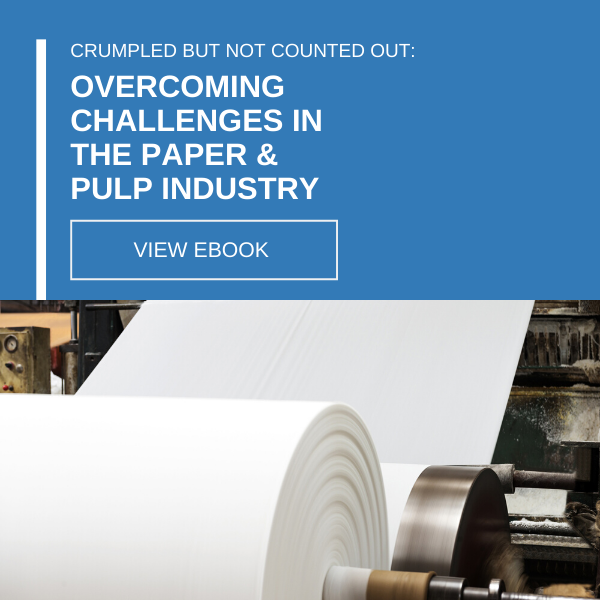
Examining COVID’s Impact on the Pulp and Paper Industry – What’s Ahead?
Every industry on the planet was impacted in some way by COVID-19, but pulp and paper really had a wild ride. Disruptions in the supply chain caused slowdowns and headaches. Manufacturing facilities hustled to make changes due to social distancing, causing more disruption and slowdowns on throughput. That’s not too different from what other manufacturing industries experienced. The difference for pulp and paper was demand.
While demand for many other products dried up, it skyrocketed for pulp and paper, including personal hygiene products (including masks), food packaging products, corrugated packaging and other paper-based materials. The surge in demand was partly due to changes in consumer lifestyle because of the pandemic. Fewer people were shopping in stores, many of which were closed, so Amazon deliveries spiked and along with that, the demand for boxes. Customers weren’t eating out in restaurants, but food delivery went through the roof, and along with that, the demand for delivery packaging. Sometimes the industry kept pace with the rising demand, and sometimes it didn’t — as anyone who tried to get toilet paper during the first months of the pandemic will attest.
As the nation, and the world, returns to normalcy, what’s ahead for pulp and paper? What are the lessons learned from the industry’s wild ride?
Anticipate continued supply chain disruptions
Pulp and paper may continue to see weak or broken links in their supply chains. It’s truly a global industry, and whether its shipping, logistics or other transportation issues snarled by travel bans, supply shortages, rising prices or anything else that affects your ability to get what you need when you need it, those problems aren’t going away quickly. The key is developing alternative supply lines and having the ability to pivot quickly. Maximizing efficiencies can minimize supply chain disruptions, as well. To read more about that, click here.
Focus on core products
Many industries are using this tactic during this still-uncertain time. Divesting, or slowing production of new products or ones that aren’t performing as well as others, allows you to focus your resources on your solid tried-and-trues. Getting back to basics is a powerful way to keep the line running with less supply, fewer people and more disruption.
Take a hard look at your operations as a whole
At USC Consulting Group, we specialize in helping companies find efficiencies. We’re suggesting to our clients across many industries to take a step back and re-evaluate during this time. Have you laid off workers? Even closed plants temporarily? Has your front-office staff been working at home? Now is the time to look at your business through the lens of what you experienced during the pandemic, and think about the practices you can carry with you into the future, including:
- Staffing levels. Do you really need to staff up to pre-pandemic levels? If you’ve gotten the same or similar throughput with fewer people on the line, it might be time to re-evaluate how many people you need to get the job done.
- Facilities. If you’ve closed a facility during the pandemic, does it need to reopen, or can you do the same or more with fewer facilities? Looking at and eliminating redundancies across all of your plants is a great way to boost your bottom line.
- Business travel. Many industries, not just pulp and paper, are reconsidering the necessity of the in-person meeting. Surely they won’t disappear altogether, and perhaps your road warriors won’t be too happy about the decline in their frequent flyer miles. But with everyone now being old pros at Zoom and other videoconferencing platforms, the expense of business travel will be increasingly hard to justify.
- Front office staff. Do you need two accountants in the office 40 hours per week? Does your sales department need to return full time? Even in a traditional manufacturing industry like pulp and paper, people are realizing that front office staff working at home, well, worked. Consolidating job functions or allowing people to continue working from home can shave dollars off of your overhead budget.
Use the SIOP process for forecasting and planning
With changing demand and continued supply chain disruptions, getting the best, clearest look at your operations and creating better strategy decisions is the key to staying agile. Many companies use sales and operations planning, or S&OP, as it is commonly known. We think that process misses a critical piece of the puzzle: inventory. Adding inventory into the mix is just one additional step, but we find it can be the key to the whole thing. When you’re focusing on inventory, it requires more careful planning and elevates the entire planning process up a notch. We like to tell our clients that the purpose of SIOP is making sure you’re having the right conversations about the right things at the right time. And getting what you need when you need it. Core components of a successful SIOP process include:
- Sales forecasting and accuracy measures
- Strategic inventory considerations
- Consistent operational capability analysis (capacity and efficiency)
- Cohesive plan with stakeholder collaboration
- Ability to execute the plan or pivot
- Report and review plan versus actual
- Analyze and implement corrective actions
At USC Consulting Group, we’ve been helping clients improve their operational efficiency for 50-plus years, through all kinds of economic weather. If you’d like to learn more about how we can help you ride out this storm and emerge more effective than before, contact us today.






